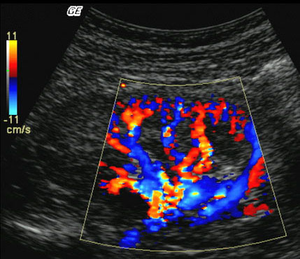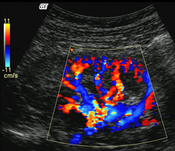Information
- Publication Type: Article in a Book
- Workgroup(s)/Project(s):
- Date: September 2014
- Address: http://link.springer.com/chapter/10.1007%2F978-1-4471-6497-5_24
- Booktitle: Scientific Visualization
- Chapter: Uncertainty, Multifield, Biomedical, and Scalable Visualization
- Editor: Charles D. Hansen, Min Chen, Christopher R. Johnson, Arie E. Kaufman, Hans Hagen
- ISBN: 978-1-4471-6496-8
- Publisher: Springer London
- Series: Mathematics and Visualization
- Pages: 283 – 303
Abstract
Radiology is one of the main tools in modern medicine. A numerous set of deceases, ailments and treatments utilize accurate images of the patient. Ultrasound is one of the most frequently used imaging modality in medicine. The high spatial resolution, its interactive nature and non-invasiveness makes it the first choice in many examinations. Image interpretation is one of ultrasound’s main challenges. Much training is required to obtain a confident skill level in ultrasound-based diagnostics. State-of-the-art graphics techniques is needed to provide meaningful visualizations of ultrasound in real-time. In this paper we present the process-pipeline for ultrasound visualization, including an overview of the tasks performed in the specific steps. To provide an insight into the trends of ultrasound visualization research, we have selected a set of significant publications and divided them into a technique-based taxonomy covering the topics pre-processing, segmentation, registration, rendering and augmented reality. For the different technique types we discuss the difference between ultrasound-based techniques and techniques for other modalities.Additional Files and Images
Weblinks
No further information available.BibTeX
@incollection{Viola_Ivan_UVP,
title = "The Ultrasound Visualization Pipeline",
author = "{\AA}smund Birkeland and Veronika Solteszova and Dieter
H\"{o}nigmann and Odd Helge Gilja and Svein Brekke and Timo
Ropinski and Ivan Viola",
year = "2014",
abstract = "Radiology is one of the main tools in modern medicine. A
numerous set of deceases, ailments and treatments utilize
accurate images of the patient. Ultrasound is one of the
most frequently used imaging modality in medicine. The high
spatial resolution, its interactive nature and
non-invasiveness makes it the first choice in many
examinations. Image interpretation is one of ultrasound’s
main challenges. Much training is required to obtain a
confident skill level in ultrasound-based diagnostics.
State-of-the-art graphics techniques is needed to provide
meaningful visualizations of ultrasound in real-time. In
this paper we present the process-pipeline for ultrasound
visualization, including an overview of the tasks performed
in the specific steps. To provide an insight into the trends
of ultrasound visualization research, we have selected a set
of significant publications and divided them into a
technique-based taxonomy covering the topics pre-processing,
segmentation, registration, rendering and augmented reality.
For the different technique types we discuss the difference
between ultrasound-based techniques and techniques for other
modalities.",
month = sep,
address = "http://link.springer.com/chapter/10.1007%2F978-1-4471-6497-5_24",
booktitle = "Scientific Visualization",
chapter = "Uncertainty, Multifield, Biomedical, and Scalable
Visualization",
editor = "Charles D. Hansen, Min Chen, Christopher R. Johnson, Arie E.
Kaufman, Hans Hagen",
isbn = "978-1-4471-6496-8",
publisher = "Springer London",
series = "Mathematics and Visualization",
URL = "https://www.cg.tuwien.ac.at/research/publications/2014/Viola_Ivan_UVP/",
}


 paper
paper
